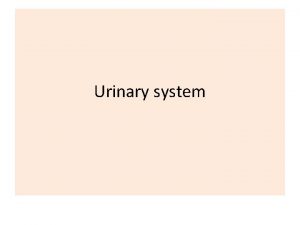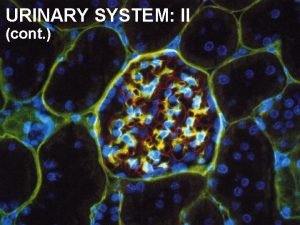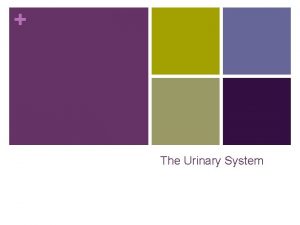Urinary System n The urinary system is composed

























- Slides: 25

Urinary System

n The urinary system is composed of 2 kidneys, 2 ureters, urinary bladder and urethra. The kidneys excrete urine.

n This passes down two muscular tubes (the ureters) into the urinary bladder which is a muscular organ. The urine is stored and is discharged through the urethra

The kidneys

One on each side of the vertebral column. They extend from the level of the 12 th thoracic vertebra to the level of the third lumbar vertebra.

The right kidney is slightly lower than the left one. It has 2 surfaces, 2 borders, and 2 ends.

The lateral border is convex; the medial border is convex at both ends and concave in the middle and presents the hilum of the kidney which gives passage to the renal vessels and nerves and the pelvis of the kidney.

The kidney is surrounded by a thin fibrous capsule. The tissue of the kidney is differentiated into an outer cortex and an inner medulla.

n The pelvis of the kidney is a dilated sac which extends outside the hilum to be continuous with the ureter.

During the course of the ureter there are 3 sites of constrictions, these sites are liable for stone impaction and they are: 1. At the pelvi-ureteric junction. 2. Where the ureter crosses the common iliac artery. 3. At the uretero-vesical junction.

n The bladder : urinary The urinary bladder is a hollow viscus with strong muscular wall which serves as a reservoir for urine.

It lies in the lower and anterior part of the pelvis. Its shape is a three sided pyramid placed on one of its angles.

n The apex of the bladder is directed anteriorly immediately behind the upper border of the symphysis pubis,

n while its base is directed posteriorly. The neck is continuous with the urethra.

The three surfaces of the bladder are one superior and two inferolateral. Each surface and the base are triangular in shape.

The superolateral angles of the base are joined by the ureters, and the inferior angle gives rise to the urethra.

n In male, the neck rests on the prostate gland continuous with the prostatic part of the urethera, in female it is continuous with the urethera.

n The capacity of the bladder is 220 cc of urine, but can accommodate up to 500 cc without discomfort.

Male urethra: It is 20 cm long. It is divided into 3 parts: 1 - The prostatic part: Is 3 cm long, begins at the neck of the urinary bladder.

It is surrounded by the prostate. It is the widest and most dilatable part of the entire urethra. The ejaculatory ducts open into the prostatic urethra.

2 - The membranous urethra: is one cm long. It is the narrowest, shortest and least dilatable part of male urethra. It is surrounded by the sphincter urethra.

3 - The spongy part: is 16 cm long and is the longest part. It traverses the penis, and ends at the glans by the external urethra orifice (meatus).

Female urethra: It is very short. It is about 4 cm long. It is wider and more dilatable than the male urethra.

n It begins at the neck of the bladder. It opens into the vestibule in front of the vaginal orifice. Its upper part is surrounded by the sphincter urethra.

 Lymphatic and urinary system
Lymphatic and urinary system Leminsci
Leminsci Anterior nucleus
Anterior nucleus Chapter 22 lymphatic system and immunity
Chapter 22 lymphatic system and immunity Urinary system introduction
Urinary system introduction Chapter 15 urinary system
Chapter 15 urinary system The cf py/o means
The cf py/o means Urinary system facts
Urinary system facts Fetal pig urinary system labeled
Fetal pig urinary system labeled Chapter 30 the urinary system
Chapter 30 the urinary system Kidney pyramid labeled
Kidney pyramid labeled Chapter 20 urinary/excretory system
Chapter 20 urinary/excretory system Urinary system model
Urinary system model Urinary system model
Urinary system model Osteichthyes
Osteichthyes Urinary system powerpoint
Urinary system powerpoint The urinary system is also known as
The urinary system is also known as Antidiuretic hormone function
Antidiuretic hormone function Renal corpuscle
Renal corpuscle Abnormal constituents of urine
Abnormal constituents of urine Spill of dye
Spill of dye Defination of urinary system
Defination of urinary system Urinary system label
Urinary system label Rat dissection
Rat dissection Rat urinary system
Rat urinary system Vena cava excretory system
Vena cava excretory system
















































